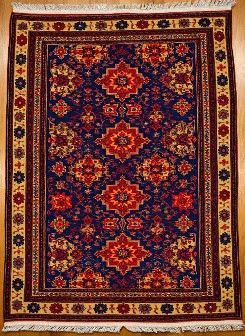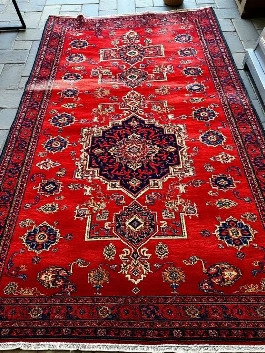All the threads in your rug have been woven with tribal tradition
Feel the bold geometry and deep symbolism of the art of weaving Caucasian rugs.

What Are Caucasian Rugs?
Caucasian rugs are hand knotted rugs made by tribal weavers throughout the Caucasus region, which includes parts of Armenia, Azerbaijan, and Georgia. They are iconic for their strong geometric forms, boldly dyed colors and their symbolic meanings. However, these rugs are more than just factory-made heirlooms, they are connected to a people’s deep pastoral heritage.
Caucasian rugs are most commonly woven from handspun wool and dyed with traditional vegetable dyes. Because of the high lanolin count in wool, as well as the unique knotting techniques for Caucasians rugs, they are incredibly soft and have astonishing durability.
The Reasons Why Collectors & Designers Are drawn to Caucasian Rugs
Caucasian rugs are often a meeting of earthy warmth and visual drama. They have a bold palette of saturated colors, and unique tribal structure, with cultural significance that make them the perfect statement in terms of classic or contemporary interiors. Not only do they survive generations with proper care, but Caucasian rugs age into more beauty and value.
Symbolism Is Ancestral In Every Design
Caucasian rugs are replete with meaning, ranging from prayer niches to eight pointed stars, ram’s horns to hooked medallions. The symbols are woven by tribal hands and serve as a link to a mountain village and highland pastures because they were once materials for protection, identification, and individual spiritual reflection.
Ancestral Symbolism In Each Design
Caucasian rugs have meaning behind every design element. There are shapes like prayer niches and eight pointed stars, as well as symbols like ram’s horns and hooked medallions. The tribal hands that wove these rugs in mountain villages and highland pastures were shape shifting moments of protection, identity, and reflection.
- Shirvan rugs are characterized by very precise patterns with fine designs which possess a high density of knots.
- There are Kazak rugs with bold medallions and lively reds, blues, and greens with a more open weave.
- The Karabagh rugs combine floral and tribal designs while influenced by some Russian and Persian designs.
- Each region’s rug tells its own story of tribal migration, local conditions, and spiritual beliefs.
Unique Elements of Caucasian Rugs
One Warp Knots Use either symmetric (Turkish) or asymmetric (Persian) knots depending on the region’s tradition; your friend’s rug relied on one or the other for construction.
Handspun Wool, and Natural Dyed produce lovely reds, indigos, and yellows from madder root, indigo plant, and pomegranate peels
Highland Wool Can withstand dirt and wear.
Flat Weave, and Pile Weave Rug construction: Rug construction is diverse. For example Soumak flatweave is used along with plenty of pile weaves making for a lot of diversity.
Here's a few Caucasian Rug types
Caucasian Rug Care Tips
Expert Cleaning of Your Caucasian Heirlooms
Protect your discoloration from taking place, and promote texture renewal, quality, and longevity of your Caucasian rug legacy with Mo’s Rug & More – our expert rug cleaners use expedient, safe, and gentle, hand-cleaning methods, and they are committed to using prescription, safe products exclusive to our trade, to avoid discoloration and potential damage to heirloom carpets.



